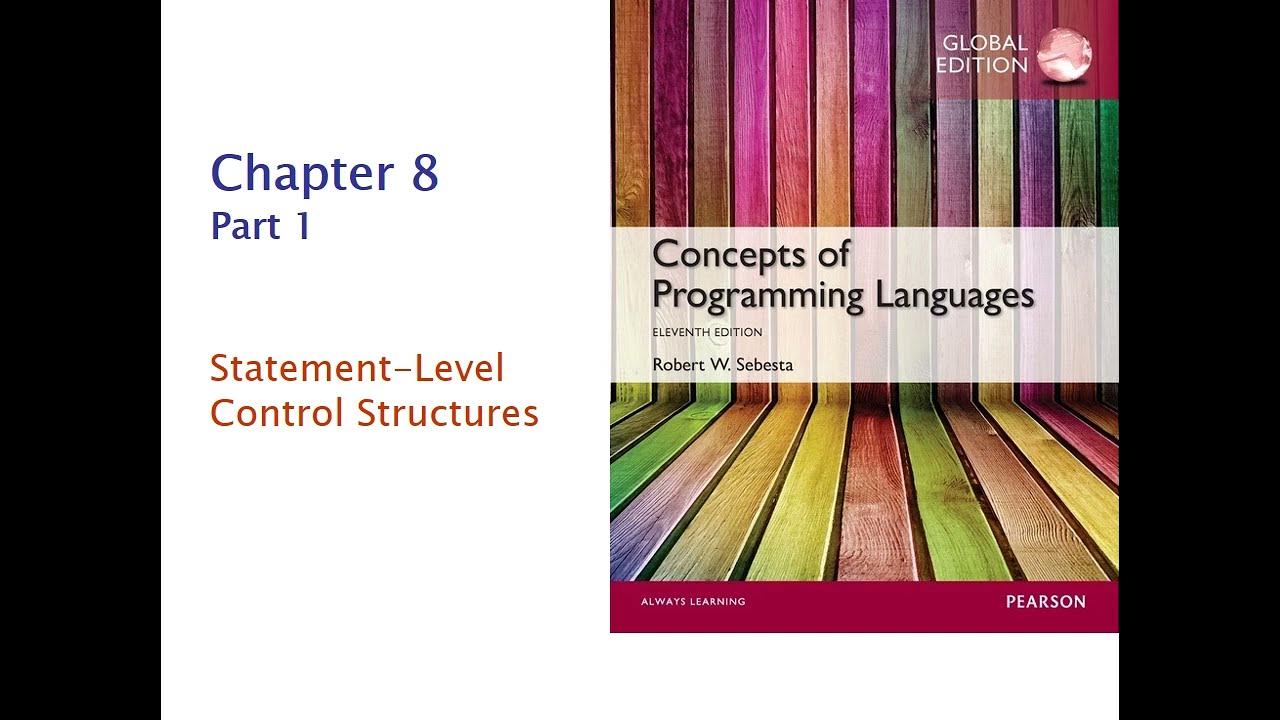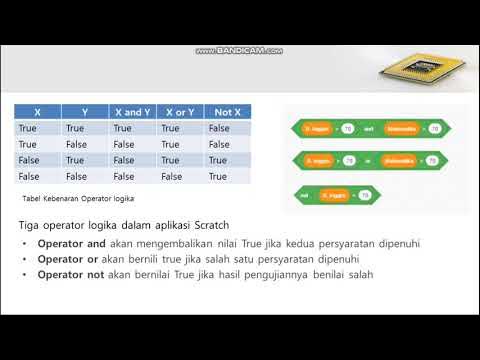COS 333: Chapter 8, Part 2
Summary
TLDRThis lecture delves into statement-level control structures, focusing on iterative statements like loops and unconditional branching with 'goto' statements. It explores design issues in loops, such as control mechanisms and variable scopes, using examples from languages like Ada, C, and Python. The lecture also touches on user-located loop control with 'break' and 'continue', iteration based on data structures, and concludes with guarded commands for concurrent programming, emphasizing their role in program correctness verification.
Takeaways
- 📚 The lecture continues the discussion on statement level control structures, focusing on iterative statements, unconditional branching, and guarded commands.
- 🔁 Iterative statements, also known as loops, are categorized into counter-controlled and logically-controlled loops, each with distinct design considerations for programming languages.
- 🔄 Counter-controlled loops involve a loop control variable that is updated with each iteration until a termination condition is met, affecting the scope, legality of modification, and evaluation frequency of loop parameters.
- 🌐 The implementation of counter-controlled loops varies across languages like Ada, C, C++, Java, Python, and F#, each with unique design choices regarding variable scope, modification within the loop, and initial evaluation of parameters.
- 🔒 Logically-controlled loops use a boolean expression for repetition control and can be either pre-test or post-test, with C and C++ supporting both forms, while Java only supports boolean expressions for control.
- 🔄 The design of logically-controlled loops in languages like C# and Ruby involves the use of iterators and blocks, providing different mechanisms for iterating over data structures.
- 🚫 Unconditional branching via 'go-to' statements is generally discouraged due to concerns about program readability and maintainability, with some languages like Java not supporting them at all.
- 🔒 User-located loop control mechanisms like 'break' and 'continue' allow for exit or resumption of loop iterations based on conditions, with some languages supporting labeled versions for more control.
- 🛡 Guarded commands, introduced by Dijkstra, support correctness verification in concurrent programming and are based on the principle of non-deterministic choice among true conditions.
- 🛠 Guarded selection and loop commands evaluate boolean expressions in parallel and execute statements based on the outcome, simplifying the verification process for program correctness.
- 🔑 The rationale behind guarded commands is to facilitate program correctness development by making the verification process simpler, which is particularly important in concurrent programming methodologies.
Q & A
What are the main topics covered in the second lecture of Chapter 8?
-The main topics covered include iterative statements, unconditional branching (goto statements), and guarded commands, with a focus on the design issues and implementation of iterative statements in various programming languages.
What is the difference between iteration and recursion for repeated execution of statements?
-Iteration and recursion are both used for repeated execution. Iteration uses loops to repeat statements, while recursion involves a function calling itself with a base condition to stop repetition.
What are the two general design issues for iterative statements?
-The two design issues are how iteration is controlled (counter-based or logically controlled) and where the control mechanism is located within the loop (before or after the loop body, or user-specified).
What are counter-controlled loops and how do they work?
-Counter-controlled loops use a loop control variable that is updated at each iteration until it reaches a termination condition, which stops the loop's execution. They specify parameters like initial value, terminal value, and step size.
What is a loop control variable and why is its scope important?
-A loop control variable is used in counter-controlled loops to track the loop's progress. Its scope is important because it determines where the variable is visible, either within the loop or outside of it.
How does the Ada programming language implement counter-controlled loops?
-Ada uses a loop control variable with a discrete range to specify the loop's values. The loop control variable is constrained to the loop body and cannot be changed within the body. The discrete range is evaluated once and is not modifiable.
What is the syntax and functionality of a for loop in C-based languages?
-In C-based languages, a for loop is introduced by the 'for' keyword, followed by three expressions separated by semicolons within parentheses, and a loop body. The first expression initializes the loop control variable, the second is the loop condition, and the third updates the loop control variable.
How do C and C++ handle the loop control variable and parameters differently?
-In C, the loop control variable must be defined outside the loop and is accessible after the loop ends. In C++, the initial expression of a for loop can include variable definitions, and the scope of these variables is limited to the loop body, making them inaccessible outside the loop.
What is the purpose of the optional 'else' clause in Python's for loop?
-The optional 'else' clause in Python's for loop executes if the loop terminates normally, i.e., it has reached the end of the range without encountering a 'break' statement.
How does F#, a functional programming language, simulate counter-controlled loops without variables?
-F# simulates counter-controlled loops using a recursive function that mimics the behavior of a for loop. The function takes a loop body and a numeric parameter indicating the number of loop executions.
What are logically controlled loops and how do they differ from counter-controlled loops?
-Logically controlled loops use a boolean expression to control repetition and are more general than counter-controlled loops. Every counter-controlled loop can be written as a logically controlled loop, but not vice versa.
What are the two design issues specific to logically controlled loops?
-The two design issues are whether the loops should be pre-test or post-test or support both, and whether logically controlled loops should be a special case of counting loop statements or be an entirely separate statement.
How do C's while loops differ from its do-while loops?
-C's while loops are pre-test loops where the control expression is evaluated before the loop body. Do-while loops are post-test loops where the loop body is executed at least once before the control expression is evaluated.
Why are go-to statements considered unsafe in programming languages?
-Go-to statements are considered unsafe due to their potential to reduce readability and increase complexity in programs, making them harder to understand and maintain.
What is the rationale behind guarded commands and how do they support program correctness verification?
-Guarded commands support a programming methodology for correctness verification by allowing the program not to specify an order of evaluation if it's not important. This simplifies the verification process and makes it easier to prove a program's design is correct.
What are the two types of guarded commands discussed in the script?
-The two types of guarded commands are the guarded selection command and the guarded loop command, both of which involve boolean expressions paired with statements and non-deterministic selection.
Outlines

Cette section est réservée aux utilisateurs payants. Améliorez votre compte pour accéder à cette section.
Améliorer maintenantMindmap

Cette section est réservée aux utilisateurs payants. Améliorez votre compte pour accéder à cette section.
Améliorer maintenantKeywords

Cette section est réservée aux utilisateurs payants. Améliorez votre compte pour accéder à cette section.
Améliorer maintenantHighlights

Cette section est réservée aux utilisateurs payants. Améliorez votre compte pour accéder à cette section.
Améliorer maintenantTranscripts

Cette section est réservée aux utilisateurs payants. Améliorez votre compte pour accéder à cette section.
Améliorer maintenantVoir Plus de Vidéos Connexes

COS 333: Chapter 8, Part 1

Conditional Statements | If-else, Switch Break | Complete Java Placement Course | Lecture 3

JAVA TECHNICAL QUESTION & ANSWERS FOR INTERVIEW PART - II

Quantified Statements | All, Some, None | Logic Simplified

[CUEE Camp 2nd] Part 2 : Condition and Loop

Informatika Kelas 8 Menggunakan Kondisi Percabangan Hal. 93-100
5.0 / 5 (0 votes)
